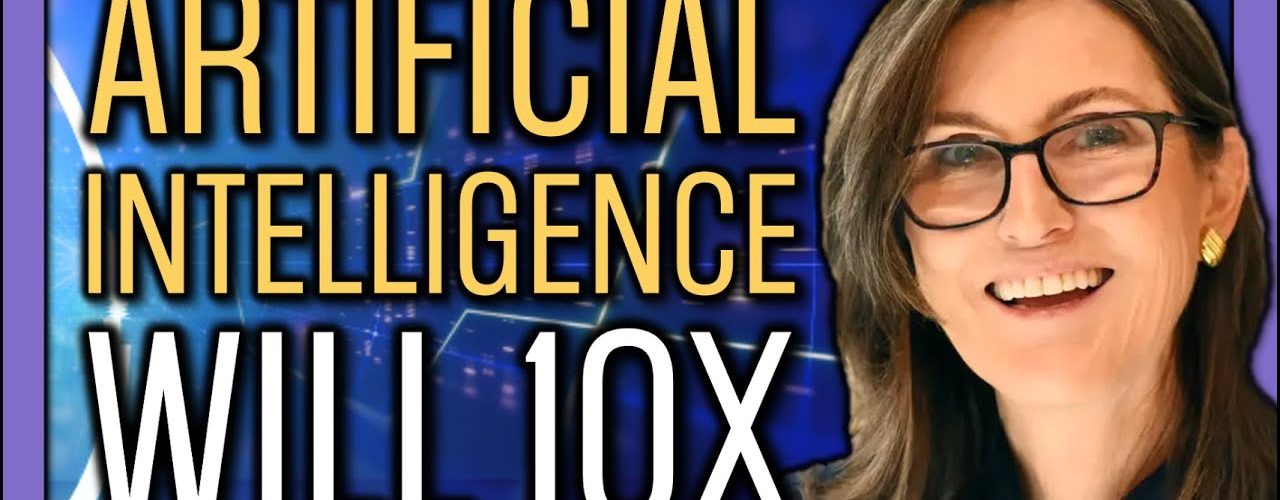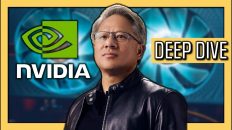Mentioned in Video:
- 💰 TRILLIONS AHEAD: ARK Invest's Big Ideas 2022 Explained ▶ https://www.youtube.com/watch?v=ni0oxRN3doY
- ARK Invest's Big Ideas 2022 ▶ https://ark-invest.com/big-ideas-2022/
- Support the channel and get extra member-only benefits by joining us on Patreon: https://www.patreon.com/tickersymbolyou
#ARKInvest just dropped their Big Ideas 2022 presentation! It's filled with great information on the advanced technologies and growth stocks found in #ARKK, @ARK Invest‘s flagship innovation fund managed by #CathieWood. This episode covers Artificial Intelligence, as well as 4 of the best stocks to buy now: Palantir (PLTR), UiPath (PATH), Microsoft (MSFT), Nvidia (NVDA), and a special stock that hasn't yet gone public!
Video Transcript:
00:01
the world is changing thanks to advanced
00:03
technologies new innovations are being
00:04
delivered faster than ever before
00:07
self-driving cars flying robots gene
00:10
editing and blockchain technologies but
00:12
there's one technology that will not
00:13
only dwarf the rest but help define them
00:15
i'm talking about artificial
00:17
intelligence which is already changing
00:19
human productivity in a fundamental way
00:21
just like the smartphone did and the
00:23
internet before it and computers before
00:25
that we need to talk about this idea
00:28
today because we can invest in this idea
00:30
today and ai could unlock over 80
00:33
trillion dollars in economic value by
00:35
2030 that's trillion with a t so in this
00:38
episode i'll highlight some of the
00:39
latest investing research on artificial
00:41
intelligence and show you five great
00:43
stocks of companies that are winning in
00:45
this market right now one of which
00:46
hasn't even gone public yet your time is
00:49
valuable so let's get right into it
00:51
starting with the super cut of arc
00:52
invests latest research on artificial
00:55
intelligence as presented in their 2022
00:57
big ideas summit within the ai space we
01:00
expect that artificial intelligence and
01:03
the associated technologies will yield
01:06
more than 100 trillion dollars in market
01:08
capitalization by 2030. there's mobile
01:10
connected devices here that includes
01:12
expectations for augmented reality
01:15
headsets and the constellation of
01:16
devices that you wear on your person
01:19
cloud computing is kind of the
01:21
infrastructure as a service layer that
01:22
gives us access to a supercomputer in
01:25
our pockets from any connected device as
01:28
a response to the demand for ai we think
01:30
there's going to be a meaningful
01:32
increase in compute hardware spin to
01:34
support it exceeding a trillion dollars
01:36
internet of things is fixed connected
01:38
devices so the smart speakers the smart
01:40
tvs and you can think of this as this is
01:43
the media retail space that lives inside
01:45
your home that allows you to
01:47
frictionlessly buy things through
01:49
e-commerce platforms and frictionlessly
01:51
access media and potentially you know
01:54
public blockchain web3 assets uh and of
01:56
course ai itself and and this drives a
01:59
lot of the value accrual expectations
02:01
here the value accrual is predicated on
02:03
the fact that
02:04
the advances in ai suggests that it's
02:06
not going to be considered artificial
02:08
intelligence but instead augmented
02:10
intelligence where every knowledge
02:11
worker will become more productive every
02:13
software engineer will become more
02:15
productive and the
02:18
productivity value that we anticipate
02:19
spilling off ai will actually
02:21
meaningfully exceed the the revenue that
02:24
ai software companies will capture the
02:26
less expensive a technology or
02:28
innovation is the more people have
02:30
access to it and the problem right now
02:32
is is neural networks are quite
02:34
expensive to trade and so if we look at
02:36
something like gpt3 in 2020 it costs
02:39
about 4.6 million dollars to train but
02:42
with cost declines it's becoming much
02:44
less expensive and so as cost declines
02:46
we're seeing more access and creating
02:48
more availability for organizations like
02:51
universities and non-profits at the
02:53
other end of the spectrum well-funded
02:55
organizations like open ai are able to
02:57
continue pushing the boundaries of
02:59
what's possible in terms of model size
03:00
and performance so just to put this into
03:03
into context gpt3 costs about 4.6
03:06
million dollars to train in 2020. if we
03:09
went back to 2015 we estimate it would
03:12
have cost about 875 million dollars to
03:14
train a model of that size so we saw a
03:17
cost decline at about 65 percent a year
03:20
from 875 million dollars in 2015 to 4.6
03:24
million dollars in 2020 based our
03:26
analysis we think that costs will
03:27
continue to climb at about 60 a year so
03:30
we could see a cost decline all the way
03:32
down to 500 by 2030. that's a decline
03:35
from 875 million dollars to just over
03:38
500
03:40
in 15 years which is pretty incredible
03:42
and to break this down a little bit
03:44
further typically when we model cost
03:46
declines at arc we do so with wright's
03:48
law so we conducted two different
03:50
studies to model cost declines in ai the
03:53
first is the cost of compute so this is
03:55
the cost of hardware and the computers
03:57
that are actually used to train neural
03:59
networks those costs will decline at
04:01
about 39 a year through 2030. the second
04:04
study we did looked at the amount of
04:06
compute required by neural networks we
04:08
think that's going to decline at about
04:10
37 a year through 2030 and so those
04:12
combined to create cost declines of
04:14
about 60 a year which is how we get that
04:17
gpt-3 estimate of 4.6 million dollars in
04:20
2020 all the way down to 500 and 2030.
04:23
so shifting to the market opportunity
04:26
for ai we think one of the most useful
04:28
applications of ai will be making human
04:31
knowledge workers more productive ai
04:33
will increase the output of knowledge
04:34
workers by about 140 percent so that
04:37
more than doubles the output of a
04:38
knowledge worker openai has a tool
04:41
called codex which could be thought of
04:43
as google translate for software
04:45
engineers a developer can put in an
04:47
english language command like make a red
04:49
ball bounce on the screen and codecs
04:51
will actually generate functional
04:53
software code that they can use in
04:55
production so if we zoom out and look at
04:57
the macro here we think that by 2030 ai
05:00
can increase the output of human
05:02
knowledge workers by about 56 trillion
05:04
dollars a year to put this in
05:06
perspective by 2030 we think knowledge
05:08
workers will have an output of about 41
05:11
trillion just alone just humans but if
05:13
we combine humans with ai we think that
05:16
output will hit 97 trillion dollars so
05:18
that's a huge step up in human output we
05:21
think that companies and organizations
05:23
are going to be willing to pay about 25
05:25
cents for every incremental dollar in
05:27
output which would suggest the market
05:30
for ai software will be about 14
05:32
trillion dollars in 2030. and so we
05:35
would see a step up from a trillion
05:36
dollars a year today to 14 trillion
05:39
dollars in 2030 which would represent a
05:41
42 compound annual growth rate so the
05:45
demand for software will likely drive a
05:47
demand for hardware the more models that
05:49
we have and the larger these models
05:50
become the more compute we need to
05:52
actually train these models and so we
05:55
think that the market for compute for ai
05:58
will increase from about 17 billion
06:00
today to about 1.7 trillion dollars in
06:03
2030. and to put this in the perspective
06:06
of overall it spend itspen historically
06:09
is hovered between four and five percent
06:10
of gdp
06:12
and so in 2022 companies spend just
06:14
under five trillion dollars a year on it
06:17
and consensus forecasts would suggest
06:19
that by 2030 that number will be just
06:21
over five trillion dollars but we think
06:23
the demand for ai could actually
06:26
increase that number by about 15
06:27
trillion dollars suggesting that spin
06:30
and it could grow from just under 5
06:32
trillion today to just over 20 trillion
06:35
dollars by 2030. if we're right the
06:37
adoption of ai could lead to one of the
06:40
greatest periods of wealth creation in
06:42
human history ai companies today are
06:44
worth about two and a half trillion
06:46
dollars
06:47
and our analysis suggests that by 2030
06:50
those companies could be worth or
06:51
companies in general could be worth 87
06:54
trillion dollars and this is a
06:55
combination of companies building both
06:57
ai applications the underlying models
07:00
and software that power those
07:01
applications as well as the hardware and
07:03
compute that's used to train those
07:04
models
07:05
ai tends to be a source of a lot of
07:07
dystopian angst what's your case for
07:10
you know utopian or or or positive
07:13
outcomes
07:15
uh that avoid the kind of worst
07:17
anxieties people have about the
07:18
proliferation of ai technology half of
07:21
the solution is understanding the
07:23
problem and i think the reason
07:25
we're understanding the problem uh maybe
07:27
a little faster than would otherwise
07:29
have been the case and and understanding
07:31
it uh more broadly is because china
07:35
wants to win at this game and they are
07:37
moving up the league tables in terms of
07:39
semiconductor uh chip manufacturing uh
07:42
focusing on ai
07:44
in terms of uh
07:46
solving the world's problems we see a i
07:50
converging with each of the platforms
07:52
including blockchain technology we see
07:55
it critical to autonomous taxi systems
07:58
and drones which are going to lower the
08:00
cost of transportation and make it much
08:03
more convenient than it is right now and
08:06
much safer much safer we see it in the
08:09
genomics space the convergence of dna
08:12
sequencing and artificial intelligence
08:15
and gene editing and other gene
08:17
therapies the convergence of those
08:19
actually curing disease we are now have
08:22
functional cures for sickle cell disease
08:25
beta thalassemia and a rare disease
08:27
called attr
08:29
we are curing disease could not happen
08:32
without artificial intelligence by 2030
08:35
artificial intelligence will touch
08:36
nearly every part of our daily lives
08:38
from search engines and streaming
08:39
services to cryptocurrencies and quantum
08:42
computing which is why it sits at the
08:44
heart of arc invest's big ideas every
08:46
single year let's talk about software
08:48
first software spending is expected to
08:50
grow at a 42 percent compound annual
08:52
growth rate for the next nine years from
08:54
roughly one trillion dollars today to
08:56
about 14 trillion by 2030. the big idea
08:59
on the software side is a huge
09:01
productivity boost to knowledge workers
09:03
like software developers bookkeepers and
09:06
office administrators one company that's
09:08
focused on exactly this is uipath ticker
09:10
symbol p-a-t-h uipath focuses on
09:13
something called rpa or robotics process
09:16
automation uipath defines rpa as a
09:19
software technology that makes it easy
09:21
to build deploy and manage software
09:23
robots that emulate human actions
09:25
interacting with digital systems and
09:26
software uipath spots are often used to
09:29
manage simple but monotonous workflows
09:31
for example parsing emails to retrieve
09:33
data that need to be entered in a bunch
09:35
of other forms or applications or how
09:37
about building a chat bot that simulates
09:39
a conversation with a human being by
09:41
answering frequently asked questions and
09:42
directing customers to useful resources
09:44
eliminating the need for a human
09:46
employee to be doing that uipath has
09:48
developed an entire suite of tools for
09:50
building and managing these bots not
09:52
just the bots themselves their platform
09:54
incorporates different capabilities like
09:56
computer vision and natural language
09:58
processing which lets people create more
10:00
advanced automations with little to no
10:01
code the goal here isn't only to put an
10:04
end to repetitive tasks but to fully
10:06
emulate human workers at least in some
10:08
roles uipath is arc invest's fifth
10:10
biggest position overall with over 900
10:13
million dollars in it across all six of
10:15
their actively managed funds the fact
10:17
that uipath sits in all six of
10:18
arkhanvest's funds matters because it
10:20
shows just how broadly impactful this
10:22
idea of automating and emulating
10:24
knowledge workers can be in every single
10:26
innovation area from genomics to
10:28
robotics from fintech to space
10:30
exploration the only other stock inside
10:32
all six arc invest funds is palantir
10:35
ticker symbol pltr and i believe it's
10:37
for the same reasons palantir builds
10:39
advanced data analytics platforms for
10:41
the government and other large
10:43
institutions many of which tend to have
10:45
a hard time with big data because they
10:46
were built well before the world went
10:48
digital to help them palantir software
10:50
automates several key big data
10:52
challenges like transporting
10:53
transforming storing securing analyzing
10:56
visualizing and predicting trends in
10:58
that data and that's just for starters
11:00
palantir focuses on rapidly digitizing
11:02
their clients businesses to make data a
11:04
part of their foundation allowing them
11:06
to interact with their digital twin then
11:09
palantir helps people make insights
11:10
based on this new foundation through all
11:12
the other cool decision support tools
11:14
their platforms offer search analytics
11:17
modeling and simulation artificial
11:18
intelligence visualization reporting and
11:21
so on palantir has been aggressively
11:23
moving down market to medium-sized
11:25
commercial businesses through their spac
11:27
investments as well as their foundry for
11:28
builders program by partnering with
11:30
companies across a wide variety of
11:32
verticals palantir has come out with
11:34
automation and analytics solutions for
11:36
anti-money laundering artificial
11:37
intelligence and machine learning
11:39
automotive and mobility supply chain
11:41
management cryptocurrencies financial
11:43
services the list goes on and on the
11:46
things all of these very different
11:47
industries have in common is that
11:48
they're using lots and lots of data from
11:50
lots of sources to make high-level
11:52
decisions that's the need that
11:54
palantir's platforms address palantir is
11:56
arc invest's 18th biggest position
11:58
overall with just under 400 million
12:00
dollars held across all six of their
12:03
actively managed funds if you're
12:04
interested in seeing my deep dives on
12:06
palutear i've put them all in one
12:08
convenient playlist for you which you
12:09
can find in the top right hand corner of
12:11
your screen right now and in the
12:13
description below as well when it comes
12:15
to artificial intelligence software is
12:17
only half the battle and demand for
12:18
software will drive demand for hardware
12:20
arc invest expects hardware spend driven
12:22
by ai to go from roughly 17 billion
12:25
dollars today to 1.7 trillion dollars by
12:28
2030 implying a whopping 67 compound
12:31
annual growth rate over the next nine
12:33
years in my opinion if you want to find
12:35
a great company that does amazing work
12:37
on both the software and hardware side
12:39
of artificial intelligence for knowledge
12:41
workers you can't go wrong with
12:42
microsoft for software and services
12:45
microsoft has things like their windows
12:46
operating system skype github linkedin
12:49
and of course their huge suite of office
12:51
tools including excel and exchange and
12:53
project and access i'm pretty sure half
12:55
of everyone's job is done using
12:57
microsoft spreadsheets in email and the
12:59
other half is done by copying code from
13:01
github that's a joke
13:03
probably microsoft also has a suite of
13:05
ai tools and intelligence applications
13:07
aimed specifically at knowledge workers
13:09
process and workflow streamlining data
13:11
visualization packages scheduling tools
13:13
and integrations on and on and on on the
13:16
computing infrastructure side microsoft
13:18
azure is one of the biggest cloud
13:20
computing services available with data
13:22
centers all over the world i get it you
13:24
already know a ton about microsoft heck
13:26
it's the second biggest company in the
13:28
world by market cap one thing you may
13:30
not know about microsoft is it's just
13:32
one of five organizations authorized for
13:34
mission-critical national security
13:36
systems at impact level five by the us
13:39
department of defense the other four
13:41
organizations that can touch systems at
13:42
this level are oracle project hosts disa
13:45
which is the defense information systems
13:47
agency and palantir that means
13:50
microsoft's azure infrastructure can
13:51
really handle any kind of situation and
13:54
network configuration and that's not
13:56
getting into any of microsoft software
13:58
or hardware focused on gaming with pcs
14:00
or the xbox microsoft is currently
14:02
working to acquire activision blizzard
14:04
for a whopping 69 billion dollars which
14:07
would be the biggest technology
14:08
transaction ever in the us if that
14:11
acquisition goes through microsoft would
14:13
own some of the biggest gaming ips on
14:14
the planet including world of warcraft
14:17
call of duty and my favorite candy crush
14:19
speaking of acquisitions just a few days
14:21
ago nvidia's bid to acquire arm from
14:24
softbank for 40 billion dollars
14:26
collapsed after regulators around the
14:28
world raised concerns arm is a british
14:30
semiconductor company that designs chips
14:32
used by apple and other huge mobile
14:34
device makers in their big ideas 2021
14:36
report archives predicted that by 2030
14:39
as much as 71 percent of data center
14:41
processors could be using arm-based
14:43
architectures by 2030 seriously
14:45
disrupting intel's x86 architecture
14:48
which is the standard today arm could
14:50
also power the majority of developer pcs
14:52
by 2030 as well for example apple has
14:55
been designing their own arm based m1
14:57
chips since late 2020. this gives all of
14:59
their product lines a common computing
15:01
architecture at the same time microsoft
15:04
is working to support windows on arm
15:05
processors not just x86 now that the
15:08
nvidia arm acquisition isn't going
15:10
through softbank plans to ipo arm by the
15:13
end of the first quarter of 2023 so
15:15
about a year from now so go ahead and
15:17
add arm to your pre-ipo watch list and
15:19
keep an eye out for which processors are
15:21
making it in to new server solutions now
15:24
let's talk about nvidia nvidia's gpus
15:26
have revolutionized high performance
15:28
computing as well as the mobile
15:30
computing markets their impact extends
15:32
way beyond high-end graphics for video
15:34
games nvidia has long been developing
15:36
solutions for machine learning data
15:38
analytics and conversational ai which is
15:40
powering revolutionary breakthroughs in
15:42
areas like speech recognition software
15:44
and natural language processing they
15:47
also build their super pods which are
15:48
their commercially available super
15:50
computers designed specifically for
15:52
artificial intelligence tasks as well as
15:54
their dgx workstations which are their
15:56
server solutions for data centers in my
15:58
opinion these machines or machines like
16:00
them will also run a serious portion of
16:02
the metaverse or whatever the next
16:04
generation of the internet will be on
16:06
the software side nvidia's omniverse
16:08
initiative is a scalable real-time
16:10
development platform for collaborative
16:12
3d design and simulation at the
16:14
foundation of the omniverse is pixar's
16:16
open source usd which stands for
16:18
universal scene description this glare
16:21
allows large groups of people to work
16:23
simultaneously across multiple software
16:25
applications on a shared 3d scene
16:27
whether it's an automotive factory floor
16:29
or the set of a movie nvidia's omniverse
16:32
is an ecosystem of development tools and
16:34
assets that grows whenever a partner
16:36
adds functionality to it via a
16:38
third-party plug-in or connector for
16:40
example apple pixar and nvidia have
16:42
collaborated to bring advanced physics
16:44
capabilities to usd nvidia and adobe are
16:47
collaborating on a substance 3d plugin
16:50
that will unlock new material editing
16:51
abilities for the omniverse and
16:53
substance 3d users the list goes on and
16:56
on but the point is that this omniverse
16:57
ecosystem is already connecting leaders
16:59
from every industry to be more than the
17:02
sum of its parts which means it'll gain
17:04
all sorts of customers and use cases in
17:06
the future talk about enhancing
17:08
productivity of knowledge workers so
17:10
there you have it hopefully this episode
17:12
helped you understand some of the latest
17:14
market research around artificial
17:16
intelligence specifically the huge 100
17:18
trillion dollar opportunity for
17:20
enhancing human productivity over the
17:22
next decade as well as a few great
17:24
software and hardware companies that are
17:26
working on the bleeding edge if you're
17:28
just looking for quicker insights every
17:29
day i'm always posting new content on
17:31
twitter instagram and tick tock yes even
17:34
tick tock so go ahead and follow ticker
17:36
symbol you wherever is most convenient
17:38
for you high-tech growth stocks like
17:40
these have been incredibly volatile
17:42
lately if you want to know more about
17:43
this area of the stock market check out
17:45
this video right here if you want to
17:47
learn more about arkhamvest's big ideas
17:49
and their market research this video
17:51
will give you a lot of bang for your
17:52
buck either way stay long stay strong
17:55
and thanks for watching until next time
17:57
this is ticker symbol you my name is
17:59
alex reminding you that the best
18:01
investment you can make
18:02
is in you
If you want to comment on this, please do so on the YouTube Video Here














